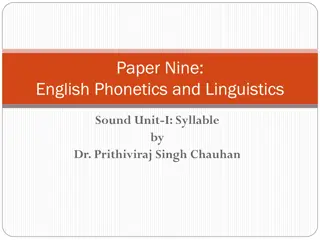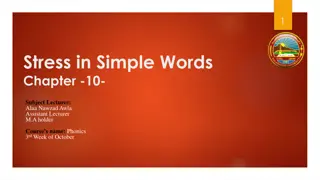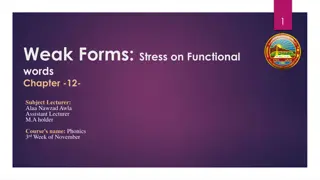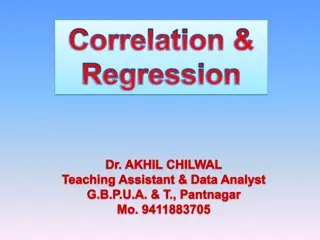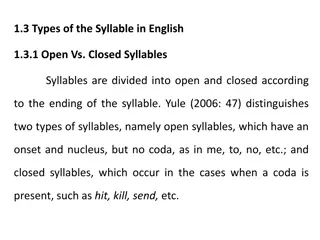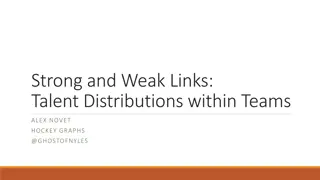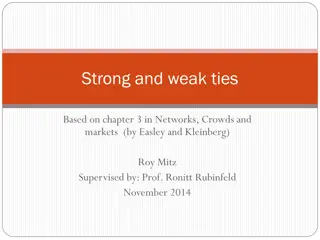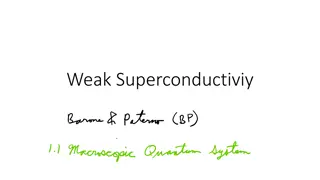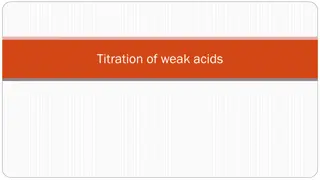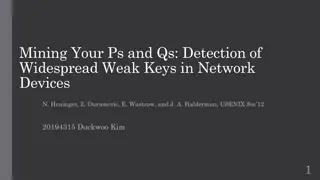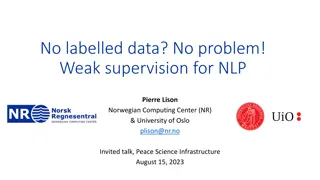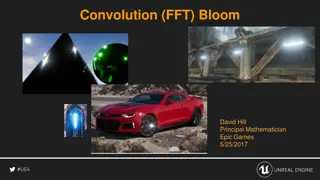Understanding English Syllables: Structure and Description
Explore the concept of syllables in English phonetics through an in-depth analysis of syllabic structure, sonority, constituents, rhyme, nucleus, coda, and phonological perspectives. Delve into the definition of a syllable, its importance in speech production, and the phonetic descriptions of syllab
2 views • 38 slides
Understanding the Importance and Nature of Syllables
Syllables play a crucial role in speech rhythm, yet their definition and identification can vary among individuals. The nature of syllables, encompassing vowels, consonants, onsets, and codas, can be analyzed phonetically and phonologically. This article explores syllable structures and phonotactics
2 views • 18 slides
Understanding English Syllables: Phonetics and Linguistics Insights
Explore the concept of syllables in English phonetics and linguistics, learning about syllable formation, examples of mono and disyllabic words, and the role of vowels and consonants in syllable structure. Delve into the essence of syllables as individual sound units within words. Discover more thro
11 views • 8 slides
Understanding Stress in English Pronunciation
Stress in English pronunciation refers to the emphasis placed on specific syllables within words. This helps distinguish degrees of emphasis or contrast in syllables, aiding in clear communication and word recognition. Learning about stress patterns is crucial for effective English communication. Th
1 views • 27 slides
Understanding Strong and Weak Forms in English Pronunciation
Exploring the concept of strong and weak forms in English pronunciation, this content discusses the importance of using weak forms in speech, the rules of occurrence of strong forms, and how to recognize the position of weak forms. Examples and explanations illustrate how function words are weakened
1 views • 25 slides
Phonics Group Activities for Syllables Learning
Engage in fun activities with Miss Plimmer, Miss Warsop, and Mrs. Hollingsworth's phonics group to explore syllables. Play games, identify syllables in words, and complete daily activities for an interactive learning experience.
0 views • 20 slides
Understanding Dactylic Hexameter in Latin Poetry
Latin poetry employs a rhythmic structure known as meter to enhance meaning and poetic effect. Particularly, dactylic hexameter is a prevalent meter in ancient epic poetry, consisting of six feet predominantly made up of dactyls—a long syllable followed by two short syllables. Scanning dactylic he
0 views • 9 slides
Mastering Open and Closed Syllables: Fun Learning Activities
Explore the world of open and closed syllables through engaging activities with words like "she," "shed," "be," "bed," "he," "hex," and more. Practice transitioning from open to closed syllables and enhance your phonics skills with interactive exercises.
0 views • 25 slides
3D Human Pose Estimation Using HG-RCNN and Weak-Perspective Projection
This project focuses on multi-person 3D human pose estimation from monocular images using advanced techniques like HG-RCNN for 2D heatmaps estimation and a shallow 3D pose module for lifting keypoints to 3D space. The approach leverages weak-perspective projection assumptions for global pose approxi
0 views • 8 slides
Understanding Central and Non-Central Forces in Physics
Newton's laws of motion introduced the concept of forces, leading to the classification of fundamental forces like gravitational, electromagnetic, strong nuclear, and weak nuclear forces. Central forces act toward or away from a fixed center, while non-central forces are affected by additional param
0 views • 7 slides
Artificial Intelligence Heuristic Search Techniques
Assistant Professor Manimozhi from the Department of Computer Applications at Bon Secours College for Women in Thanjavur is exploring Artificial Intelligence concepts such as weak methods and Generate-and-Test algorithms. The content covers heuristic search techniques like generating and testing, hi
0 views • 7 slides
Understanding Correlation and Regression in Data Analysis
Correlation and Regression play vital roles in investigating relationships between quantitative variables. Pearson's r correlation coefficient measures the strength of association between variables, whether positive or negative, linear or non-linear. Learn about different types of correlation, such
0 views • 26 slides
Understanding Syllable Types in English Language
Syllables in English are categorized into open and closed syllables based on their endings. Open syllables have an onset and nucleus without a coda, while closed syllables include a coda. Additionally, syllables can be simple (with a vowel or single consonant) or complex (with consonant clusters). T
1 views • 6 slides
Strong vocational interest blank
Strong Vocational Interest Blank, introduced in 1927 by Edward Kellog Strong Jr., assesses individuals' career preferences based on their likes and dislikes across various dimensions. The Strong-Campbell Interest Inventory, a revised version, includes 124 occupational scales and 23 Basic Interest Sc
0 views • 12 slides
Understanding Buffer Solutions and pH Indicators
Buffer solutions resist changes in pH upon the addition of acids or bases, maintaining a stable pH level. They consist of a weak acid and its conjugate base or a weak base and its conjugate acid. pH indicators are weak acids or bases that exhibit color changes based on their degree of dissociation a
0 views • 21 slides
Understanding Tonic Solfa and "Do-Re-Mi" in Music
Tonic solfa is a method of teaching music using solfege syllables like Do, Re, Mi, Fa, So, La, Ti, Do. The iconic song "Doe, a Deer" from "The Sound of Music" famously uses these syllables to teach pitch and melody. Explore the world of solfa notation and how it helps in music education and practice
0 views • 7 slides
Understanding Weak Signal Propagation in Radio Waves
This informative content delves into weak signal propagation and its various aspects related to electromagnetic waves, particularly in the context of radio communication. It covers topics such as radio waves, radio horizon, knife-edge diffraction, tropospheric scatter mode, auroral reflection, and m
1 views • 37 slides
Adapting Contest Strategies for Declining Solar Cycle 24 and Solar Cycle 25 Precursors
As Solar Cycle 24 rapidly declines, preparations for the subsequent Solar Cycle 25 are crucial. Insights on weak solar activity, potentially weak Cycle 25, and the impact on contest strategies are discussed. Improved DX propagation, reliable openings, and signal strengths to Europe and Japan, amidst
0 views • 12 slides
The Vital Role of Encryption in Safeguarding the Digital Economy
Encryption plays a crucial role in protecting the digital economy by providing secure communication channels. Professor Peter Swire from Ohio State University emphasizes the need for strong encryption over weak cybersecurity measures. He discusses the history of wiretaps, the shift to strong cryptog
0 views • 15 slides
Understanding Acids and Bases in Chemistry
Acids donate protons, while bases accept them. Strong acids ionize completely while weak acids only partially ionize, resulting in a Ka value less than one. Water, being amphoteric, can both donate and accept protons. The ionization of water leads to a constant Kw value of 10^-14. Explore the ioniza
0 views • 15 slides
Understanding Latin Syllables and Vowel Length Rules
Learn about the division of Latin words into syllables based on vowels, the rules for accent positions, distinguishing long and short vowels through special marks, and recognizing syllables that are always long or short. Explore how Latin vowels are categorized by nature and marked in dictionaries t
0 views • 24 slides
Exploring the Art of Writing Sonnets and Understanding Iambic Pentameter
Uncover the beauty of sonnets and the significance of iambic pentameter in poetic works. Dive into the rhythmic structure, syllables, and poetic meter, discovering the allure and impact of writing in iambic pentameter alongside exploring the phonological intricacies of syllables.
0 views • 25 slides
Weak Interactions and Hydrogen Bonding in Molecular Forces
Exploring van der Waals forces, hydrogen bonding, and weak interactions in intermolecular forces and surface interactions. Understanding interactions between backbone peptide groups and orientation dependence of hydrogen bonding through dispersion forces and repulsive potentials.
0 views • 22 slides
Understanding Plain & Reinforced Concrete Structures
Concrete is a vital construction material, with Plain Cement Concrete (PCC) and Reinforced Cement Concrete (RCC) being common types. PCC lacks reinforcement and is strong in compression but weak in tension. On the other hand, RCC combines concrete with steel reinforcement for improved tensile streng
0 views • 10 slides
Understanding Strong and Weak Links in Team Talent Distributions
Talent distributions within sports teams can vary greatly, affecting team performance. The concepts of strong and weak links in team dynamics are explored through examples in hockey, shedding light on how having the best player or avoiding the worst player can impact outcomes. The correlation betwee
0 views • 13 slides
When I Am Weak, Then I Am Strong: Understanding Strength in Weakness
In 2 Corinthians 12:6-10, the apostle Paul reflects on how a thorn in the flesh humbled him, leading to a greater understanding of God's grace and strength in weakness. This passage emphasizes that true strength is found in acknowledging our dependence on Christ, allowing His power to be perfected i
0 views • 7 slides
Understanding Iambic Pentameter: Shakespeare's Versification
Iambic Pentameter is a verse rhythm popular in Shakespearean works, featuring 10 syllables per line with alternating stressed and unstressed beats. It distinguishes high-class characters from lower-class ones and allows for creative variations by changing stress patterns and adding syllables. An Iam
0 views • 47 slides
Understanding Strong and Weak Ties in Social Networks
Explore the concepts of strong and weak ties in social networks based on Easley and Kleinberg's theories. Delve into the flow of information, structural differences among nodes, and the evolution of networks over time. Discover the significance of triadic closure principle and clustering coefficient
0 views • 60 slides
Understanding Buffers in Chemistry
Buffers play a crucial role in maintaining stable pH levels in solutions. They are composed of a weak acid and its conjugate base or a weak base and its conjugate acid. This summary covers the definition of buffers, differentiation between buffer and non-buffer systems, the behavior of buffers when
3 views • 23 slides
Dynamo and Bayou: High Availability and Weak Consistency in Modern Applications
Dynamo and Bayou databases offer high availability and weak consistency, making them suitable for modern applications with super high demands. Examples of suitable applications include flight ticket booking, Amazon shopping carts, and more. Availability is crucial for accommodating millions of custo
0 views • 38 slides
Understanding Weak Superconductivity and Functional Coordinates
Delve into the realm of weak superconductivity and the significance of functional coordinates in this informative presentation. Explore the intricacies of these concepts through a series of visually appealing slides that shed light on their characteristics and applications. Gain insights into the re
0 views • 8 slides
Understanding the Titration of Weak Acids and Amino Acids
Titration is a crucial technique used to determine the properties of weak acids and amino acids. This process involves calculating pH values, degree of ionization, and understanding the ionization equilibrium of different acid-base systems. Various examples, including glycine hydrochloride, isoelect
0 views • 15 slides
Understanding Acids and Bases: Ionization and Properties
Acids donate protons while bases accept them. Strong acids and bases ionize completely, while weak acids ionize partially. Water is amphoteric, capable of both accepting and donating protons. The equilibrium constant Kw for water is 10^-14. Understanding the ionization of weak acids and weak bases h
0 views • 15 slides
Weak Keys Detection in Network Devices
TLS and SSH rely on RSA and DSA for security, but weaknesses in random number generation can lead to widespread weak keys among hosts on the Internet. This paper uncovers the prevalence of repeated keys and easily inferred private keys, emphasizing the importance of entropy pools in key generation.
0 views • 28 slides
Weak Visibility Queries of Line Segments in Simple Polygons - Overview
This information discusses weak visibility queries of line segments in simple polygons, focusing on topics such as visibility of line segments, visibility polygons, visibility graphs, and related previous work on preprocessing and data structures for visibility queries in simple polygons.
0 views • 26 slides
Mastering Weak 2 Opening Hands in Bridge Strategy
Learn the history and strategies behind weak 2 opening bids in Bridge, including the goals, rules, and considerations like suit quality, point range, and vulnerability. Expert recommendations emphasize the importance of partnership agreements for successful preempts.
0 views • 23 slides
Understanding Acids and Bases in Chemistry: Key Concepts and Terminology
This chapter delves into the fundamental concepts of acids and bases in chemistry, covering Arrhenius, Bronsted-Lowry, and Lewis definitions. It discusses conjugate acids and bases, acid dissociation, dissociation of strong and weak acids, and the differences between strong and weak acids/bases. The
0 views • 41 slides
Weak Supervision for NLP: Overcoming Labelled Data Challenges
Addressing the challenge of acquiring labelled data for NLP models, weak supervision techniques offer solutions through alternative annotation methods and leveraging diverse data sources. This talk highlights the importance of overcoming the scarcity of labelled data in machine learning and NLP task
0 views • 18 slides
Memory Models: Enhancing Semantics for Programs with Data Races
This content delves into the importance of establishing stronger memory models to provide better semantics for programs experiencing data races. It highlights the challenges faced due to weak semantics in programming languages like C++ and Java, emphasizing the need for improved memory models to add
0 views • 61 slides
Understanding Bloom Effects in Game Design
Bloom effects, such as weak scattering and convolution, enhance the visual appeal of games by simulating light scattering. They add realism and customization options to game graphics, improving the overall visual experience. Weak scattering causes subtle yet impactful effects like glare and diffract
1 views • 14 slides


